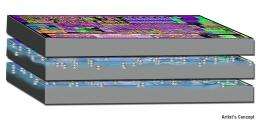ICECool to crack thermal management barrier, enable breakthrough electronics

The continued miniaturization and the increased density of components in today’s electronics have pushed heat generation and power dissipation to unprecedented levels. Current thermal management solutions, usually involving remote cooling, are unable to limit the temperature rise of today’s complex electronic components. Such remote cooling solutions, where heat must be conducted away from components before rejection to the air, add considerable weight and volume to electronic systems. The result is complex military systems that continue to grow in size and weight due to the inefficiencies of existing thermal management hardware.
Recent advances of the DARPA Thermal Management Technologies (TMT) program enable a paradigm shift—better thermal management. DARPA’s Intrachip/Interchip Enhanced Cooling (ICECool) program seeks to crack the thermal management barrier and overcome the limitations of remote cooling. ICECool will explore ‘embedded’ thermal management by bringing microfluidic cooling inside the substrate, chip or package by including thermal management in the earliest stages of electronics design.
“Think of current electronics thermal management methods as the cooling system in your car,” said Avram Bar-Cohen, DARPA program manager. “Water is pumped directly through the engine block and carries the absorbed heat through hoses back to the radiator to be cooled. By analogy, ICECool seeks technologies that would put the cooling fluid directly into the electronic ‘engine’. In DARPA’s case this embedded cooling comes in the form of microchannels designed and built directly into chips, substrates and/or packages as well as research into the thermal and fluid flow characteristics of such systems at both small and large scales.”
The ICECool Fundamentals solicitation released today seeks proposals to research and demonstrate the microfabrication and evaporative cooling techniques needed to implement embedded cooling. Proposals are sought for intrachip/interchip solutions that bring microchannels, micropores, etc. into the design and fabrication of chips. Interchip solutions for chip stacks are also sought.
“Thermal management is key for advancing Defense electronics,” said Thomas Lee, director, Microsystems Technology Office. “Embedded cooling may allow for smaller electronics, enabling a more mobile, versatile force. Reduced thermal resistance would improve performance of DoD electronics and may result in breakthrough capabilities we cannot yet envision.”
Provided by DARPA


















